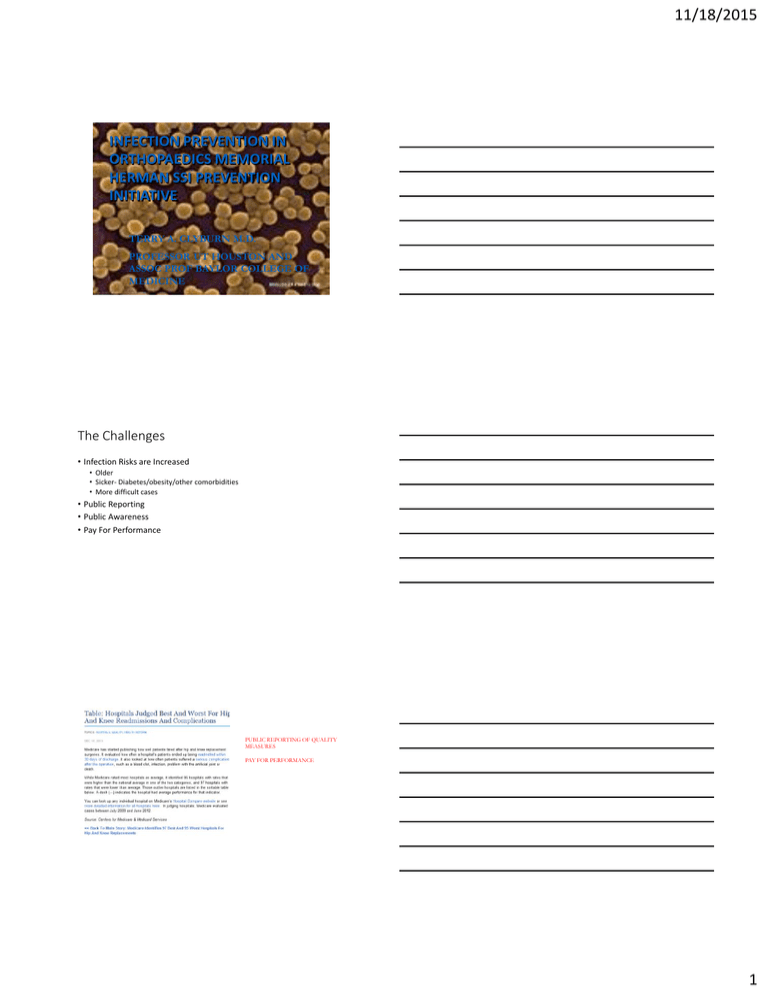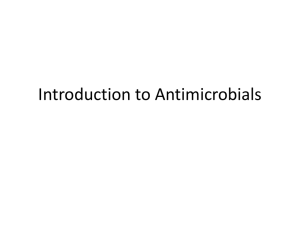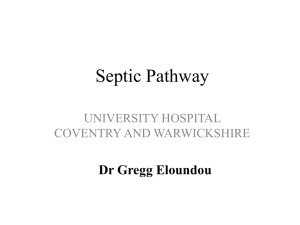infection prevention in orthopaedics memorial herman ssi
advertisement

11/18/2015 INFECTION PREVENTION IN ORTHOPAEDICS MEMORIAL HERMAN SSI PREVENTION INITIATIVE TERRY A. CLYBURN M.D. PROFESSOR UT HOUSTON AND ASSOC PROF BAYLOR COLLEGE OF MEDICINE The Challenges • Infection Risks are Increased • Older • Sicker- Diabetes/obesity/other comorbidities • More difficult cases • Public Reporting • Public Awareness • Pay For Performance PUBLIC REPORTING OF QUALITY MEASURES PAY FOR PERFORMANCE 1 11/18/2015 MEMORIAL HERMANN LIMITATIONS RECONSTRUCTION OF MULTIPLY INJURED AND OFTEN PREVIOUSLY INFECTED SICK PATIENTS; OBESE, DIABETES, TRANSPLANT, HEMOPHILIA. (THE ONES THE OTHERS DON’T WANT! Conclusion: Including revision surgeries in the calculation of SSI rates can result in higher infection rates for institutions that perform a larger number of revisions. Differences between primary and revision surgeries should be considered in national standards for the reporting of SSI’s. 2 11/18/2015 CONCLUSION: Multiple patient comorbidities independently contribute to infection risk after TJA. Preoperative TJA infection risk stratification may be feasible and should be investigated further. Conclusion: Previous fracture or remnants of internal fixation are major risk factors for SSI. SO WHAT CAN WE DO? Predisposing Factors and Patient Optimization • Obesity: Malinzak- BMI>50-odd ratio 21.3 compared to cohort • MHH: BMI >45 not recommended. • ASA/Charlson Co-Morbidity: Parvizi: correlate with PJI risk. • Glycemic control- Marchant: HbA1C uncontrolled, odds ratio 2.31 • Mraovic; Preop >112 is risk, post op day one >200 (2x risk). • MHH- HbA1C> 7: not recommended, Glucose >200 post op triggers review. • Nutritional Status: Serum transferrin <200, Albumin< 3.5, total lymphocyte ct <1500/mm3– Increased risk of PJI • Anemia: greater risk of transfusion- Pulido- “transfusion is risk for PJI” 3 11/18/2015 Predisposing Factors and Patient Optimization • Renal dialysis: Sakalkale- high early complication rates in dialysis patients. (58%). • Stop antiplatelet drugs at least one week preop. • Herbal meds: Garlic, gingo biloa, Kava, St. Johns. Wort, Echinacea • Rhematologic agents- RA risk of PJI- 2.6X risk • • • • • • Methotrexate- stop 1 wk before, hold for 2 weeks Sulfasalazine/azathioprine- 1 wk prior Leflunomide- 2 wk prior Hydoxychloroqine- may treat perioperative. Biologic response modifiers- etanercept etc- 2weeks prior and 1-2 wk after. Gout/ colchicine/alloprurinol/probenicid- continue up to morning of surgery. CDC recommends shower with antiseptic solution at least the night before surgery. Mangram, Am J Inf Cont, 1999 CHG Cochrane review- no evidence reduced SSI Other studies show effectivenessJohnson: JOA 2010 Zywiel: Int. Orthop 2011 Eiselt Orthop Nurs 2009 Pre-OP Skin Cleansing • Chlorhexidine-Alcohol vs. Povidone-Iodine for Surgical Site Antisepsis • NEJM 2010 • 6 VA Hospitals • 849 subjects • CHG statistically reduced superficial and deep incisional infection, but not “deep organ” infections. 4 11/18/2015 Preoperative Antibiotics • ASHP Guidelines; Cefazolin or Cefuroxime recommended for lower extremity arthroplasty. • Active against Staph species and enteric organisms. • Cefazolin dose; 1 gm if <80kg or 2 if > 80kg. (2 for all?). • Start within one hour before skin incision • Repeat if 2.5X half life (about 4 hr) or if 70% circ vol blood loss. • No evidence of efficacy greater than 24 hr post-op. • Even if cath or drain. Preoperative Antibiotics • Indications for Vancomycin • • • • • • • Carrier or prior MRSA Exposure to nursing home, dialysis unit, recent hospitalization (one year). Health care workers Penicillin Allergy (Consider Clinda, but be aware of C diff). Must be given slowly, “Red Man” etc. Start 90 min pre-incision. MHH uses weight base protocol. Use with Cephalosporin if possible to cover non resistant Staph. THE OR- LAMINAR FLOW OR HEPA FILTRATION? Facts! • INFECTION REDUCED-ULTRACLEAN AIR AND BODY EVACUATION SUITS • LAMINAR FLOW- REDUCTION IN AIRBORNE BACTERIAL COLONY FORMING UNITS (CFU’S) • NO PROVEN REDUCTION IN INFECTION RATE PROVEN • CDC Recommendations • Positive pressure relative to corridors • Greater than > 15 air exchanges/hr (>3 fresh). • Filter all air with filters of 90% efficiency • In non-LAF rooms, introduce air at ceiling and exhaust near floor. 5 11/18/2015 Preventing Surgical Infection Environmental Control • Operating Room Environment • Lidwell 1982- direct correlation between Deep SSI and the number of airborne micro-organisms. • Literature controversial- some studies show efficacy, some actually show increased risk. One issue if “other confounders”. UV Light Multiple studies show effectiveness, but harmful exposure to OR personel 6-28X recommended levels. Preventing Surgical Infection Environmental Control • Operating Room Environment • Laminar Flow – “Consider performing orthopedic implant operations in operating rooms with ultra clean air and body exhaust suites” – CDC • Laminar Flow - After decades of clean-air operating rooms, no uniform opinion about the efficiency in preventing infections has been achieved Preventing Surgical Infection Environmental Control • American College of Healthcare Architecture • maintain positive pressure in the conventional operating room and provide greater than 15 operating room volumes exchanges per hour • Recommend HEPA Filtration 6 11/18/2015 BODY EVACUATION SUITS • Ritter, CORR 1999- shedding of OR personnel directly related to contamination- but never shown to be related to SSI. • PROTECTS PATIENTS FROM SHEDDING OF BACTERIA AND HAIR FROM EXPOSED SKIN, AND MUCOUS MEMBRANES OF OR PERSONNEL. • Charnley: Showed 9% reduction to 1% SSI with LAF and Body Suit. • Lidwell showed a 2.6x increase in SSI with standard OR gowns. • REVERSE ISOLATION MAYBE AN IMPORTANT CONSIDERATION. Preventing Surgical Infection Environmental Control- WASH YOUR HANDS! • Operating Room Environment • CDC recommends either: • Extensive use of antimicrobial soap scrub for several minutes OR • Alcohol-based hand rub. • MHH- Soap scrub for 3-5 minutes first scrub then CHG subsequently. (unless become contaminatedrepeat soap scrub). SURGEON-HAND SCRUB • SCRUB WITH ANTIMICROBIAL SOAP FOR 2-6 MINUTES • 10 MINUTES NOT NECESSARY AND MAY IRRITATE • DRY HANDS AND APPLY ALCOHOL BASED PRODUCT 7 11/18/2015 SURGEON-HAND SCRUB • ALCOHOL BASED SCRUBSIMMEDIATE REDUCTION IN RESIDENT FLORA BY 95% AND 99% WITH REPEATED APPLICATIONS • CONTINUES TO LOWER COUNTS DURING SURGICAL PROCEDURE. TIMING OF HAIR REMOVAL • Shaving immediately before = 3.1% SSI rates • Shaving 24 hrs before = 7.1% SSI rates • Shaving >24 hrs before = 20% SSI rates IF YOU NEED TO SHAVE- DO IT IMMEDIATELY BEFORE SURGERY! HAIR REMOVAL • HAIR REMOVAL• METHOD • Safety razor- highest SSI rate3.1%. • Depilatory or no hair removal low SSI rate– 0.6% • Electric razor is alternative. • DO NOT USE SAFETY RAZOR Tanner- Cochrane database, 2006 meta-analysis- lower SSI with clippers. 8 11/18/2015 SCRUB ATTIRE AND OR BEHAVIOR ALL HAIR MUST BE COVERED OPERATING ROOM ENVIORNMENT • Operating Room Environment Andersson, Am J Inf Cont, 2012 Traffic=contamination OR contamination- shedding • Keep doors closed and limit traffic in and out of the operating room • Eliminate needless activity • Eliminate needless personnel • Settle plate studies- number and movement in OR related to number of colonies. Rothman Institute Door Openings-primary 60 (0.65/min) -revision 135 (0.84/min) Mostly circulator/equip Rep 47% “no real reason to come or go”. Other Intraoperative Measures • Skin/Deep knife: controversial literature; recently Schindler (JBJS Br 2006) found coag neg staph common on skin blades. Recommended routine changing of blade. • Gloving • Double vs triple controversial • Change frequently• Al-Maiyah – frequent change lowered risk of perforation/contamination • Dawson-Bowling- 12% and 24% of gloves collected after draping and before opening the final components- were contaminated. • Davis: JBJS Br, 1999: 28.7% gloves contaminated after draping. • PRP- no evidence of benefit in TKA (Peerbooms, ACTA Orthop 2009), (Diiorio, CORR, 2012), (Horstmann, 2011). 9 11/18/2015 Patient Surgical Scrub • vonEiff; NEJM 2011: 80% of HAI are S.aureus from patients own epidermis. • Betadyne scrub and paint- proven effectiveness. • Iodophor-in-alcohol proven effective and improves drape adhesion. • My protocol-alcohol-scrub-paintdry-apply CHG-let dry-apply iodophor drape. • CDC- no specific agent recommended: Mangram Am J inf Con, 1999. Incise Drapes Prevents bacterial penetration and lateral movement of bacteria. Bacteria do not multiply beneath the drape. Wound contamination reduced from 15% to 1.6%. Drapes in general, Blom showed only impermeable drapes are adequate. Preventing Surgical Infection Environmental Control • Patient Environment • Monitor and maintain normal glycemia • Maintain normothermia (above 36 degrees) Lower temp=lower oxygen partial pressure and reduced T cell and neutrophil function. • Use of FAW has been questioned, but no real evidence exists. CDC recommends; Room temp 6873 F and 30-60% humidity. 10 11/18/2015 Preventing Surgical Infection Wound Environment Surgical technique • Minimize operative time • Maintain hemostasis, gentle handling of tissue, eradicate dead space, remove dead tissue and foreign bodies. • Peersman- surgical time>2.5 hrsexponential increase risk of PJI Contamination Reduction • Surgical Trays- Dalstrom- do not open until after skin prep and drape and then cover with sterile towel. • Splash Basins- Multiple studies show contamination. Multiple authors recommend against use and against reuse of instruments from basin. • Suction Tips- Robinson: 1993- up to 41% of suction tips are contaminated. Many authors recommend changing the tip. Irrigation Techniques • No evidence that antibiotic irrigation is effective in prophylaxis of infection in orthopaedic procedures.1 • Betadyne solution found to be significantly better than normal saline alone.2 • Several studies show detergents and castile soap to lower bacterial counts. 3,4 1. Roth et all, Pharmacotherapy 1985; 5:222-227. 2. Cheng et. al., Spine 2005 3.Burd et. al, Am J Orthop, 1999. 4. Anglen et. al., Int Orthop., 2003. 11 11/18/2015 How Much Irrigation? • One study found that 4 Liters of pulsatile lavage was needed to remove all particle of cement. Niki et. al., J. Arthroplasty, 2007. Pulse Lavage or Bulb Syringe? • “Pulse lavage group-significantly lower infection rate” (Hargrove, J Hosp Inf, 2006) • “High pressure pulsatile lavagegreater penetration of bacteria into tissue”(Counter-Hassinger, CORR, 2005). DRAINS • Theoretically reduce the risk of hematoma and thus infection. • No clear evidence of any benefit. • Raises concern of tract drainage and passageway of infection. • One study showed increase risk of positive culture of drain if left in more than 24 hours. Drinkwater and Neil, J. Arthroplasty,Apr 1995;10(2):185-189. 12 11/18/2015 DRAINS • Meta-Analysis • Drains increase transfusion need post total hip and knee and has no major benefit. • Study of bilateral total knees with and without drains. • No difference in swelling, or persistent drainage, quadraceps function, or range of motion. Parker et al, JBJS:2004:86A(6):1146-1152. Beer et al, JBJS 1991:73-1(4):584-586. DRAINS • New Study in JOA 2010 • 143 THA’s, 3 Groups • No drains • Drains for 24 Hours • Drains for 48 Hours • No differences in Infection, Duration of Serous Drainage or Blood Loss • Only difference was less thigh swelling and pain in drain group. Suture Materials? • Kirpensteijn et. al., VetQ, 1997 • Dog study • Monocryl vs. Vicryl • Less inflammation early but no difference late. Niessen et. al., Ann Plastic Surgery 81 Breast reduction cases compared Vicryl to Monocryl Less inflammation and keloid formed with Monocryl. Justinger et. al., Surgery 2009 Compared abdominal wound closure with Vicryl vs. Vicryl Plus (Triclosan) Vicryl 10.8% infection Vicrly Plus 4.9% infection 13 11/18/2015 Anticoagulation • Over anticoagulation- Increased risk of PJI • Garvin: JBJS 2011. • Parizi: JOA 2007. Local Vancomycin Powder • Literature support for use in instrumented spine surgery. (Molinari, 2012: Sweet, 2011:O’Neill 2011) • No current evidence for use in total joints. Use of Antibiotic Cement • Parvizi- meta-analysis- 50% decrease in primary and 40% decrease in revision THA’s. • Antibiotics elute from PMMA. • Two distinct applications with different formulations. • Treatment: 4.0 – 10.0 gm per 40 gm PMMA. • Prophylaxis: 0.5 – 1.0 gm per 40 gm PMMA Local antibiotic level far exceeds MIC for most bacteria. 14 11/18/2015 Prophylaxis • High dose ALPMMA aminoglycoside elution effective treatment. • What about prophylaxis? • Antibiotic bone cement has been approved by the Food and Drug Administration (FDA) in the United States for use in second stage revision of infected total joint arthroplasties. Use of Antibiotic Cement • Norwegian Arthroplasty Register 2006 - Revision rates in 56,275 cemented and uncemented primary THAs followed for 0-16 years. • Risk of revision due to infection was the same for uncemented and cemented arthroplasties with antibiotic-loaded cement, but 1.8 times higher for cemented arthroplasties without antibiotic cement. • Findings can be explained by reduced resistance to infection caused by the cement, which appears to be neutralized by adding antibiotic to the cement. Antibiotic Cement Prophylaxis • Antibiotic bone cement and systemic antibiotics was found to be significantly more effective in preventing deep infection than using systemic antibiotics alone or antibiotic bone cement (P<0.001). • In more than 100,000 patients, no reports of an allergic reaction. • Potential risks of resistance do not appear to have materialized. • Potential ill affect: we will stop or accept fewer complex cases. 15 11/18/2015 ANTIBIOTIC PROPHYLAXIS • ANTIBIOTIC CEMENT • Comparison of 178 total knees with Cefuroxime impregnated cement vs. 162 without added cement. • Both groups had 2 superficial infections. • The antibiotic cement group had no deep infections, but there were 5 in the control group. Fang-Yao Chiu, JBJS, 2002, Vol 84-A(5),759-761. CONCLUSIONS • PUBLIC REPORTING IS HERE. • PAY FOR PERFOMANCE IS HERE. • TERITIARY CARE CENTERS HANDLE THE MOST DIFFICULT CASES AND THE RESULTS ARE COMPARED TO COMMUNITY HOSPITALS. • SILVER LINING; WE ARE GETTING 100% SUPPORT FROM OUR ADMINISTRATION AND STAFF TO MINIMIZE SSI THANK YOU! 16






